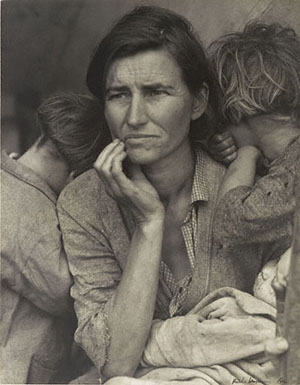• Who is in this picture? How do you think they are related? What do you see in the picture that gives you clues?
• How would you describe the woman's expression?
• What does the woman's gesture tell you about how she is feeling?
• Do you think Lange posed the two older children to face away from the camera? If you think she did, why would she have done this?
• How do you think the public responded to this photograph when it was published in a newspaper?
• Years later, Florence Owens Thompson did not want this picture published anymore because she felt it labeled her as "poor" when she no longer was. If it had been up to you, would you have honored her request? If a subject agrees to be photographed, should they be able to control how the photo is later used? |
This picture of an exhausted mother, consumed with worry over the survival of her children, is one of six photographs that Lange took in the span of just a few minutes at a pea-pickers' camp. She had returned to the camp on an impulse after having driven twenty miles past it at the end of a long day of work. The woman in the picture, Florence Owens (1903-1983), was the widowed mother of eight children at the time this photograph was taken. She had been with her family in the Imperial Valley picking beets. They were on their way to Watsonville to work in the lettuce fields when car trouble forced them to stop at the Nipomo pea-pickers' camp. Lange found Owens waiting for her sons to return with the needed parts.
Regardless of the particular circumstances of her being in that place at that time, the mother's pose of stoic anxiety and the encumbrance of her three young children conveyed a universal message. Americans were shocked when they saw photographs of this family published in the San Francisco News, and the federal government immediately sent twenty thousand pounds of food to the starving workers. In the years following its initial publication, Migrant Mother came to represent the Great Depression itself.
Florence Owens eventually had three more children, and her family kept moving, following the California crops. Owens became involved in efforts to organize farm labor and would sometimes serve as the "straw boss," or the one who negotiated wages for migrants as the picking season began. She was still doing field work at the age of fifty, before marrying George Thompson and settling into a stable life in Modesto, California. |
